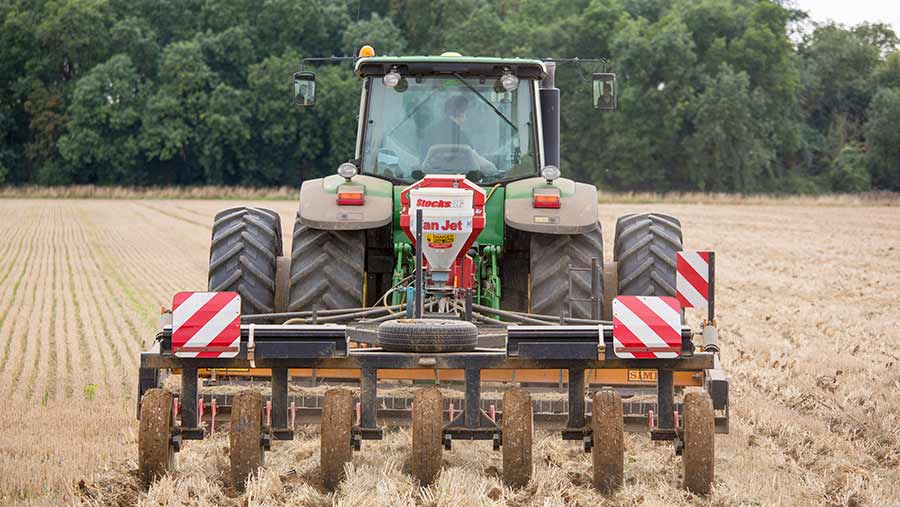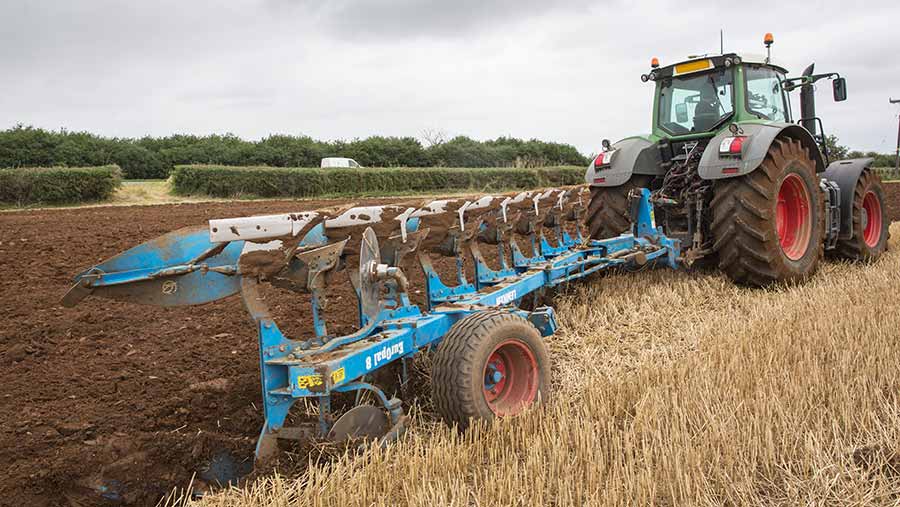Pros and cons of 6 different OSR establishment techniques
 © Tim Scrivener
© Tim Scrivener There is a wide range of establishment methods for oilseed rape and the most suitable technique will depend on soil type, soil conditions, prevailing weather and likely weed and slug pressures.
As well as selecting a method that suits soil conditions and availability of machinery, costs can influence choice.
In recent years, low-cost, one-pass establishment systems have become popular, even though any potential savings can be lost if establishment is patchy or the crop fails.
See also: Why strip-till is key part of one farmer’s cultivations approach
Oilseed rape and soil compaction are not a good combination, which is why establishment systems that include a deep loosening leg are in demand – whether that’s done as a separate pass or is part of the drill being used.
Either way, in dry conditions seed should be sown as soon as possible after cultivations to minimise soil moisture loss and ensure that the seed germinates.
Rolling after sowing is advised in most situations, to retain moisture and reduce slug risk.
With techniques where crop residues are being retained, a straw rake may be required to uniformly spread the residue.
Uneven distribution of large amounts of trash can be a problem – both with its effect on germination and its ability to harbour slugs.
Otherwise, the aim of any cultivations prior to establishment is to:
- Correct compaction
- Maximise seed-to-soil contact
- Sow seed at 2-3cm depth
- Retain soil moisture
- Limit weed numbers
- Reduce slug risk
Autumn nitrogen, applied up to a maximum of 30kg/ha in Nitrate Vulnerable Zones, is often used to boost early crop growth, especially where minimal soil disturbance means that no mineralisation is taking place.
1. Broadcasting
Broadcasting is a quick and cheap option, as seed is spread into standing cereals, often via Autocast.
It can be a high-risk option, as it may cause poor and uneven establishment. The main threat is that chopped straw or trash is not distributed evenly, forming a dense mat, which can impede the seedlings.
As a result, slug damage can be higher than with other systems.
In addition, broadcasting does not allow the use of treated seed or pre-emergence herbicides, as the seed is not covered.
Seed rates tend to be higher than with other methods, to compensate for the variability in establishment achieved.

© Tim Scrivener
However, it can be done when the ground is too wet to allow deep cultivations. There is very little soil moisture loss, a benefit in dry years, and the long stubble left acts as a deterrent to pigeons. Broad-leaved weeds are unlikely to be a problem.
2. Direct drilling
A less risky technique than broadcasting in most seasons, direct drilling can work well where there is little or no surface tilth present and soils are well structured.
A low-cost, one-pass technique, it minimises soil moisture loss and new drill technology allows accurate placement of seed and good slot closure. Fertiliser can be applied at the same time.
Again, uneven trash distribution can be a risk to good establishment, so a stubble rake may be necessary.
Weed numbers tend to be reduced, due to minimal soil disturbance, so pre-emergence herbicides are often not required.

© Tim Scrivener
The use of companion crops is becoming increasingly popular with direct drilled crops, where they help to improve rooting, confuse pests and recycle nutrients.
The companion plants are either killed by winter frosts or taken out with a targeted herbicide.
3. Strip tilling
Strip tillage is a low-disturbance tillage practice where only a narrow band of soil is cultivated to produce tilth. The remaining soil is left undisturbed, with crop residues retained on the soil surface.
A popular technique for establishing oilseed rape, strip tillage allows the seed to be placed accurately and most systems have the facility to put a band of fertiliser underneath the seed.
Another one-pass system, it is quick and brings costs down. Drill technology has improved in recent years, increasing the consistency and reliability of the system as well as allowing wide or conventionally-spaced rows.
Uneven crop residue distribution is a potential problem, both for establishment and pests. Leaving a longer stubble can help to deter pigeons.
4. Subcasting
Subcasting places seed in soil disturbed by widely spaced tines, such as those on a subsoiler.
It works well in drier soil conditions and where there is compaction, but often runs into difficulties in wet soils due to slotting and poor drainage.
It allows seed to be placed into a prepared seed-bed at less than 5cm deep and can cope with crop residues, as the legs are widely spaced.

© Tim Scrivener
The depth of the pass will depend on soil conditions. It is essential to roll afterwards and a broad-leaved weed herbicide is usually required.
5. Non-inversion tillage
Non-inversion tillage offers the greatest flexibility and deals with any surface compaction.
It is suitable for most soils and conditions and makes use of either disc or tined cultivators, often with a seeder unit attached.
This means it can be a single-pass operation or drilling can be done with a cultivator drill in a separate pass.

© Tim Scrivener
Whichever way it is done, consolidation is important for good seed-to-soil contact. It will also help to reduce slugs.
Pre-emergence herbicides will be required in most situations.
6. Ploughing systems
Ploughing can produce an excellent seedbed, providing secondary cultivations achieve good consolidation and retain soil moisture.
However, it is expensive to perform and time-consuming, so tends to only be used as a last resort before oilseed rape or where grass weed numbers are too high.
It is an effective method of reducing compaction and can help improve crop rooting.

© Tim Scrivener
Tight turnaround times and high costs mean that it is used infrequently before oilseed rape drilling – especially as it also leads to soil moisture loss.
Pros and cons of five different OSR establishment techniques |
|||
|
Technique |
Cost |
Pros |
Cons |
|
Broadcast into standing crop |
£ |
|
|
|
Direct drill/Strip-till |
££ |
|
|
|
Sub-cast |
£££ |
|
|
|
Min-till |
££££ |
|
|
|
Ploughing |
£££££ |
|
|
Farm trial findings
Establishment costs can be reduced without compromising the output or profitability of oilseed rape growing, according to farm trials conducted in Herefordshire.
Seven different establishment methods were compared side-by-side in 24m-wide blocks of Elgar on Russell Price’s farm near Ledbury last year, with all of the methods including a deep loosening leg as either a separate pass or an integral part of the drill.
Costs ranged from £131/ha down to £54/ha – with the cheapest system representing a £77/ha saving over the most expensive regime.
“It was interesting to note that the second cheapest system was the highest yielding,” says Mr Price, who is one half of the joint AHDB Hereford Monitor Farm. “That was reassuring, as it’s the system we favour on this farm.”
He adds that the best performing blocks of oilseed rape weren’t the most pleasing to look at.
“If we’d judged them on cosmetics alone, then the more conventional establishment systems looked the best.
“Although they all yielded well, the direct drilled plots based on the DTS concept came out on top at 5.68t/ha. Our thinking is that it’s all down to the strength of the root.”
There was very little difference between the Sumo and the Mzuri, he notes, although the Mzuri’s 60cm-wide row spacing wasn’t as good in terms of yield as 30cm-wide rows.
Mr Price adds that while the findings were of interest, he is wary of reading too much into them after just one year of results.
“In another season, things might have been different. It’s one of the issues that oilseed rape growers are up against.”
The trial is being repeated this year, with two further drills joining the line-up to be assessed.
Costs and yields of eight different approaches being trialled at Town Farm |
||||
|
Primary |
Secondary |
Tertiary |
Cost £/ha |
Yield t/ha |
|
Subsoil |
Power harrow combination |
Roll |
123 |
5.164 |
|
Single Pass Min Till |
Power harrow combination |
Roll |
131 |
5.041 |
|
Single Pass Min Till |
Min till cultivator drill |
Roll |
112 |
5.016 |
|
Subsoil |
Min till cultivator drill |
Roll |
104 |
5.164 |
|
Subsoil |
Sumo DTS |
Roll |
118 |
5.090 |
|
None |
Sumo DTS |
Roll |
67 |
5.683 |
|
None |
Mzuri (narrow leg spacing) |
Roll |
67 |
5.213 |
|
None |
Mzuri (wide leg spacing) |
Roll |
54 |
4.649 |

